U.S. Environmental Footprint Factsheet
The U.S. population is expected to grow from 333 million in 2022 to 404 million by 2060.1,2 One way to quantify environmental impacts is by estimating how many Earths would be needed to sustain the global population if everyone lived a particular lifestyle. One study estimates it would take just over 5 Earths to support the human population if everyone’s consumption patterns were similar to the average American.3 Pressure on the environment will increase unless consumption patterns are significantly adjusted to account for the finite natural resource base. Factsheets expanding on the topics below are available from the Center for Sustainable Systems.
Food (See U.S. Food System Factsheet)
- The average American’s daily Calorie consumption increased from 2,054 in 1970 to 2,501 in 2010.4
- In 2003, the average American consumed 46 gallons of soft drinks, a 330% increase since 1947.5 Between 1970 and 2021, per capita milk consumption decreased 51%, to 10.6 gallons per year.6
- The average American consumes about 356 calories of added sugars and sweeteners per day. The American Heart Association recommends limiting added sugars to between 100 and 150 calories daily for an average adult.4,7
- U.S. per capita consumption of added fats increased by 66% from 1970 to 2010.4
- Approximately 41% of U.S. adults and over 20% of adolescents age 12-19 are obese (BMI > 30).8
- In the U.S. between 30-40% of food is wasted. Food waste is the most commonly landfilled and incinerated material in the U.S.9 The average American wastes 50% more food than in 1970.10 This waste accounts for roughly 22% of the municipal solid waste stream and represents a loss of $450 per person each year.10,11
U.S. Daily Per Capita Caloric Intake by Food Type, 1970-20174
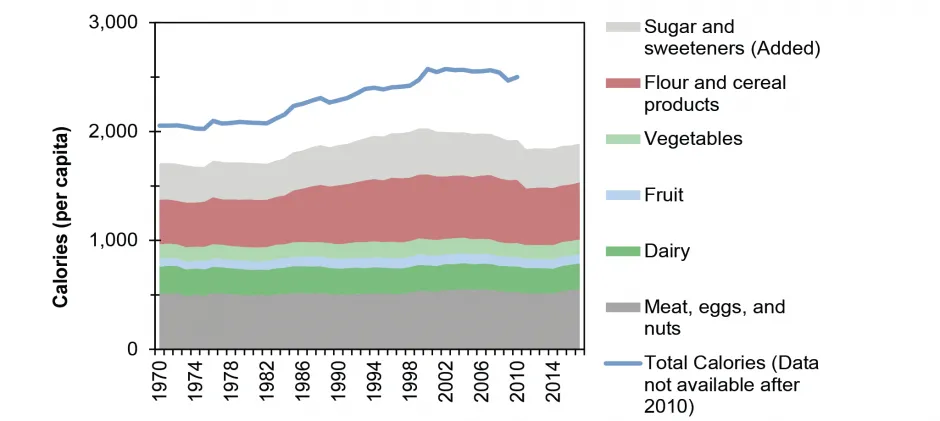
Water (See Factsheets Related to Water)
- In 2015, total water withdrawals in the U.S. for all uses were estimated to be 322 billion gallons per day, 9% less than in 2010. The biggest uses are thermoelectric power (41%), irrigation (37%), and public supply (12%).12
- Water use per person was roughly 48% higher in western states than eastern states in 2015, mostly due to crop irrigation in the west.12 Over 50% of water withdrawals occur in 12 states, 9% in California.12
- The average North American household uses roughly 240 gallons of water daily for indoor and outdoor uses.13
- Households with more efficient fixtures and no leaks can drop their water usage to 40 gallons per person per day.13
North American Household Water Use13 Gallons Per Household Per Day
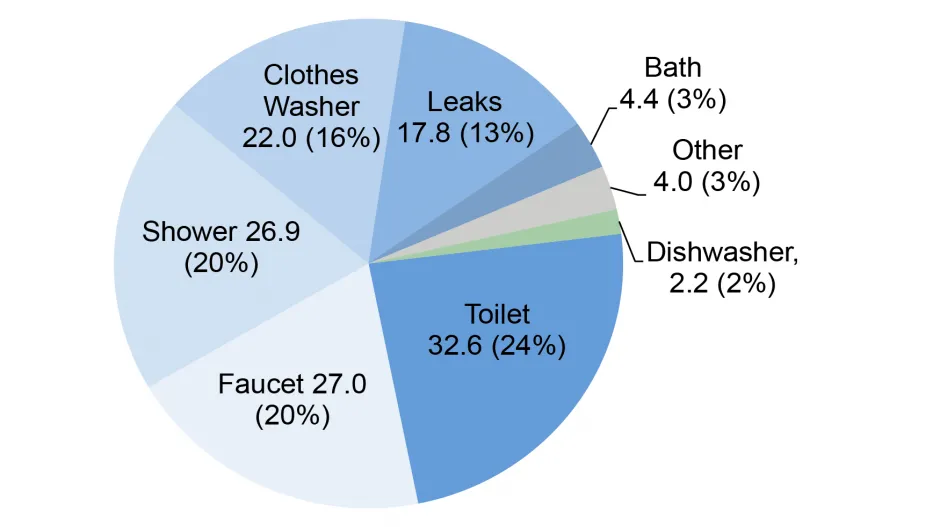
Material Use and Waste Management (See Factsheets Related to Material Resources)
- In 2000, per capita consumption of all materials in the United States was 23.7 metric tons (t), 52% more than the European average.15
- In 1900, raw material consumption was less than 2 t per person. At its peak in 2006, it had grown to over 13 t per person.16,17
- In 2018, the average American generated 4.9 lbs of municipal solid waste (MSW) each day, with only 1.6 lbs recovered for recycling or composting.11 For comparison, MSW generation rates (lbs/person/day) were 2.20 in Sweden, 2.98 in the U.K., and 3.71 in Germany.18
- In 2018, 32.1% of U.S. MSW was recovered for recycling or composting, diverting 94 million U.S. short tons of material from landfills and incinerators—more than double the value from 1990.11
- Only 53% of Americans are automatically enrolled in curbside recycling programs. In 2016, 82% of cities with curbside recycling collect material single-stream, meaning materials such as glass and paper are separated at the recycling plant.19,20
Average American Lifetime Material Consumption14
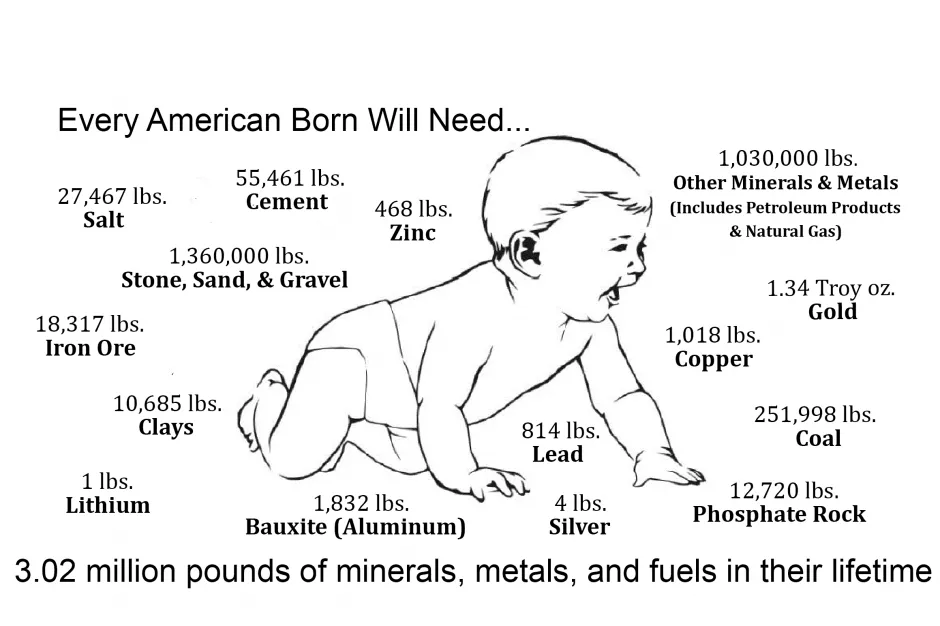
Greenhouse Gases (GHG) (See Greenhouse Gases Factsheet)
- In 2021, U.S. GHG emissions were 19 t CO2e per person.21,22
- From 1990-2019, total annual U.S. GHG emissions increased by 2%. In 2020, due to the COVID-19 pandemic, emissions fell by 9%. In 2021, total annual U.S. GHG emissions increased by 5%, but still remained below 1990 levels. Emissions from electricity generation, 25% of the U.S. total, are included by sector in the figure (at right).21
- In 2023, the Intergovernmental Panel on Climate Change (IPCC) concluded that: “human activities, principally through emissions of greenhouse gases, have unequivocally caused global warming, with global surface temperature reaching 1.1°C above 1850-1900 in 2011-2020.”23
- By choosing energy efficient products to reduce electricity consumption and by making smart transportation choices, individuals can immediately reduce the greenhouse gas emissions they are responsible for.
U.S. GHG Emissions, 202121 (Million metric tons (Mt) CO2 e)
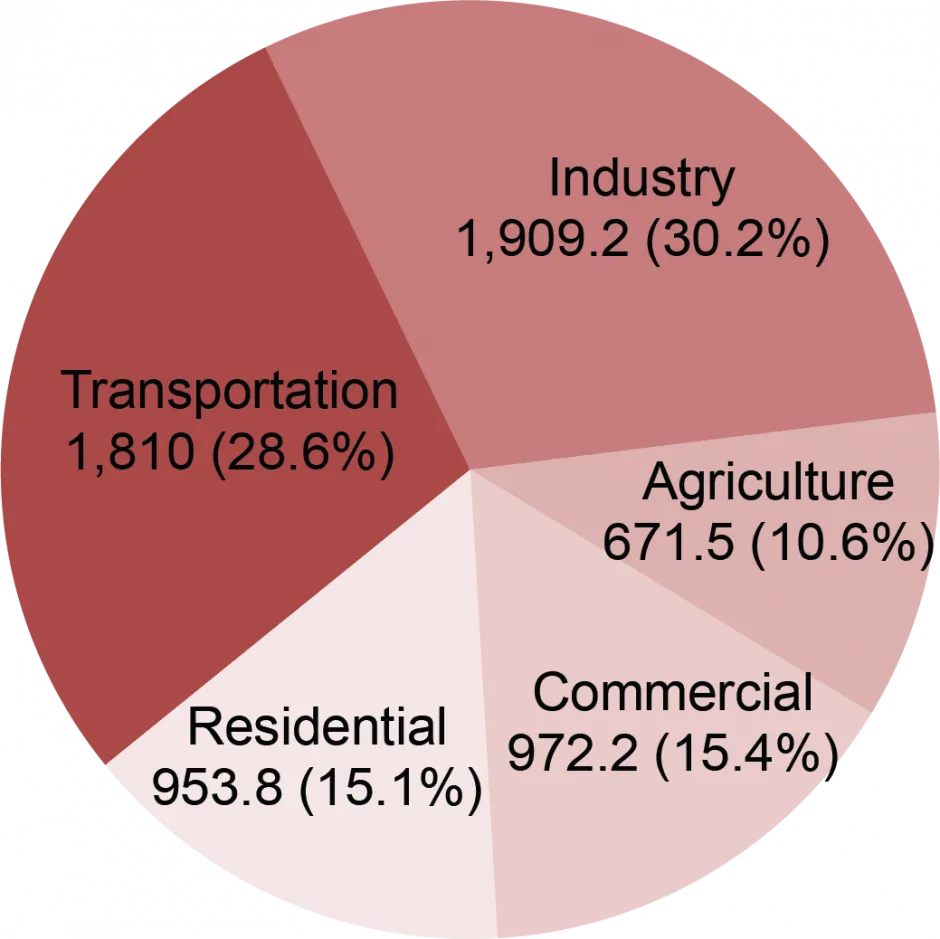
Residential and Commercial Buildings (See Factsheets Related to the Built Environment)
- Since the 1970s, average residential living trends in the U.S. have been towards bigger houses with fewer occupants:
- U.S. house size increased 21.4%.24
- Number of occupants per house decreased 14%25
- Living space per person increased 41%.24,25
- Significant energy savings could be realized by better insulating residential buildings to reduce the space heating and cooling loads, using energy efficient appliances, and using more efficient lighting in commercial buildings.
- Commercial building average site energy intensity per square foot decreased 19% from 115,000 Btu/sqft in 1979 to 96,500 Btu/sqft in 2022.1,26
- The amount of developed U.S. land increased by 61% from 1982 to 2017, making up 6% of total U.S. surface area in 2017.27
Commerical and Residential Buildings Primary Energy Distribution, 20221
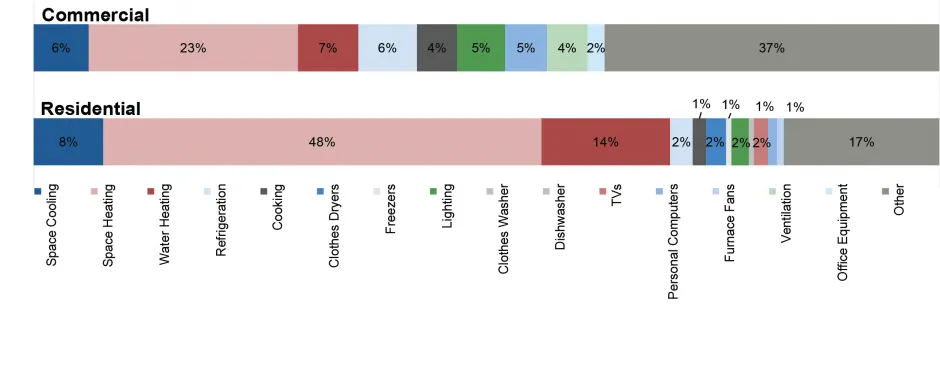
Transportation (See Personal Transportation Factsheet)
- In 2021, the U.S. had 282.4 million vehicles, 49.6 million more than licensed drivers.28
- Drivers traveled over 3.1 trillion vehicle-miles in the U.S. in 2021, more than double the amount traveled in 1980.28 This is equivalent to more than 6 million round-trips to the moon.29
- Compared to 1990 models, the average 2022 vehicle’s weight increased by 26%, horsepower increased by 101%, and acceleration increased (i.e., 0-60 mph times dropped) by 35%.30
- Fuel economy surpassed 1988 levels in 2009 after years of decline.31
- The average vehicle occupancy for a passenger car is 1.5, compared to 7.5 for a transit bus and 26.1 for a train.32
- Congestion is a worsening urban problem, causing an additional 8.7 billion hours of travel time, 3.5 billion gallons of fuel use, and 68.6 billion pounds of CO₂ emissions by urban Americans in 2019.33
U.S. Modes of Transportation to Work in 202033

Energy
- In 2021, the U.S. spent $1.3 trillion on energy ($3,954 per person), equal to 5.7% of GDP.35
- More U.S. energy comes from petroleum than any other source, comprising nearly 35% of consumption.34
- Daily U.S. per capita energy consumption includes 2.56 gallons of oil, 8.43 pounds of coal, and 266 cubic feet of natural gas. Residential daily electricity consumption is 12.5 kilowatt-hours (kWh) per person.1,34
- With less than 5% of the world’s population, the U.S. consumes 16% of the world’s energy and accounts for 16% of world GDP. In comparison, the European Union has 6% of the world’s population, uses 10% of the world’s energy, and accounts for 15% of world GDP; China has 18% of the world’s population, consumes 27% of the world’s energy, and accounts for 19% of world GDP.36,37
U.S. Energy Consumption: Historic and Projected1,34
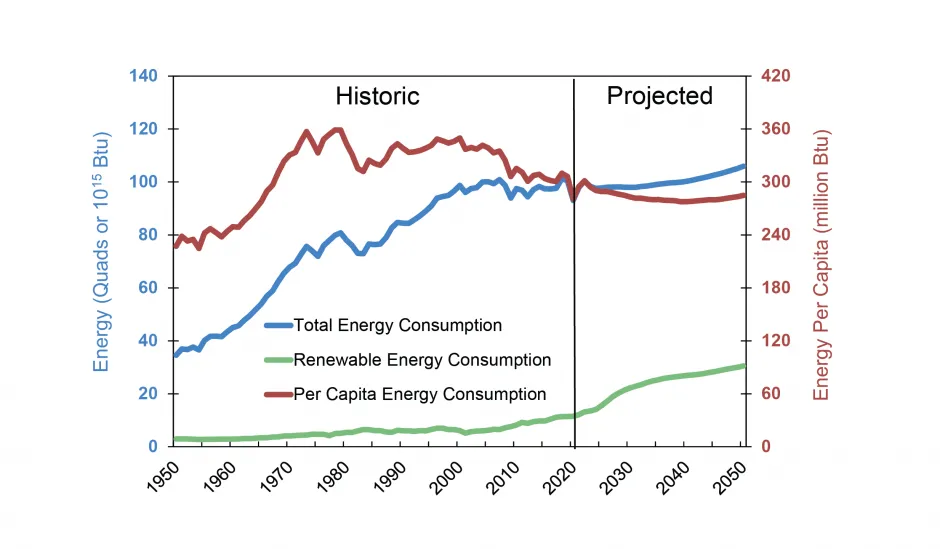
Center for Sustainable Systems, University of Michigan. 2023. "U.S. Environmental Footprint Factsheet." Pub. No. CSS08-08.
References
- U.S. Energy Information Administration (EIA) (2023) Annual Energy Outlook 2023.
- U.S. Census Bureau (2018) “Projected Population Size and Births, Deaths, and Migration Main Projections Series for the United States, 2017-2060.”
- Global Footprint Network (2022) Public Data Package.
- U.S. Department of Agriculture (USDA), Economic Research Service (ERS) (2019) Loss-Adjusted Food Availability, Calories.
- USDA, ERS (2016) “Beverages: Per capita availability.”
- USDA, ERS (2022) Loss-Adjusted Food Availability, Dairy.
- American Heart Association (2018) “Sugar 101.”
- U.S. Department of Health and Human Services (2021) “Health, United States, 2019.”
- U.S. Environmental Protection Agency (EPA) (2022) “United States 2030 Food Loss and Waste Reduction Goal.”
- Natural Resource Defense Council (2017) “Wasted: How America Is Losing Up to 40 Percent of Its Food from Farm to Fork to Landfill.”
- U.S. EPA (2020) Advancing Sustainable Materials Management: 2018 Fact Sheet.
- Dieter, C., et al. (2018) “Estimated use of water in the United States in 2015.” U.S. Geological Survey Circular 1441.
- Water Research Foundation (2016) Residential End Uses of Water, Version 2 Executive Report.
- Mineral Education Coalition (2022) “Mineral Baby.”
- World Resources Institute (2008) Material Flows in the United States: A Physical Accounting of the U.S. Industrial Economy.
- U.S. Geological Survey (2017) Use of Raw Materials in the United States from 1900 Through 2014.
- U.S. Census Bureau (2000) Historical National Population Estimates: July 1,1900 to July 1, 1999.
- Organization for Economic Co-operation and Development (2015) Factbook 2015: Municipal Waste.
- The Recycling Partnership (2020) 2020 State of Curbside Recycling Report.
- U.S. EPA (2017) The 2016 State of Curbside Report.
- U.S. EPA (2023) Inventory of U.S. Greenhouse Gas Emissions and Sinks: 1990 - 2021.
- U.S. Census Bureau (2023) Population Estimates, Population Change, and Components of Change 2020-2022.
- Intergovernmental Panel on Climate Change (IPCC) (2023) Synthesis Report of the IPCC Sixth Assessment Report (AR6) Longer Report.
- U.S. Energy Information Administration (EIA) (2023) Residential Energy Consumption Survey, 2020.
- U.S. Census Bureau (2022) Historical Household Tables
- U.S. EIA (2012) Annual Energy Review 2011.
- USDA National Resource Conservation Service (2020) Natural Resources Inventory 2017.
- U.S. Department of Transportation, Federal Highway Administration (2023) Highway Statistics 2021.
- National Aeronautics and Space Administration (2022) “Earth’s Moon: Our Natural Satellite.”
- U.S. EPA (2022) 2022 Automotive Trends Report.
- U.S. EPA (2021) 2021 Automotive Trends Report.
- U.S. DOE, Oak Ridge National Lab (2022) Transportation Energy Data Book: Edition 40.
- Texas A&M Transportation Institute (2021) 2021 Urban Mobility Report.
- U.S. EIA (2023) Monthly Energy Review May 2023.
- U.S. EIA (2023) State Energy Data System 2021.
- U.S. Central Intelligence Agency (2023) The World Factbook.
- U.S. EIA (2023) “International Energy Data - Total Energy Consumption.”

